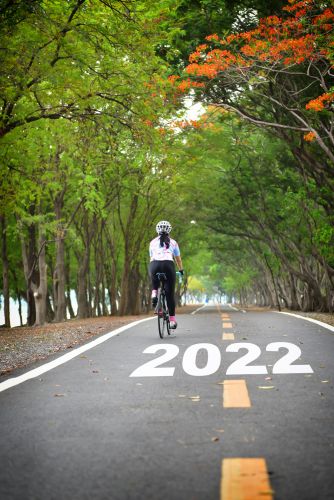It's the time of year when people ask what happens next for the bike business. And business has been booming for two years now, but nothing lasts forever. So, what's next?
Lots of things, doubtlessly, ranging from the tantalizing to the disastrous. Here are five of the most interesting possibilities that might (or might not) actually happen to our industry in the next twelve months, together with an estimate of their likelihood.
1. Channel-wide overstock
What goes up must come down, and nowhere is this more true than with respect to demand for bicycles. And if demand drops off while the whole channel is stuffed to the gunwales with product and booked out for more than a year, the results may be disastrous.
This is hardly a new position for the bike business. We had nearly a decade of ongoing product oversupply from the end of the Great Recession in 2010 until 2018, along with the season-long markdowns that go with them. But here's what's different for 2022. Given how far into the future production is currently booked, a sudden drop in demand could make those 2010-2018 years look like child's play for suppliers and retailers alike.
Suppliers say their forecasting abilities have improved, allowing them to be more agile in response to changes in demand, but that ability has yet to be pressure-tested. And a sudden drop in demand would put huge amounts of pressure on the system, virtually overnight.
Likelihood of actually happening: 50%
2. The battle for company-owned stores heats up
Trek's ongoing program of buying up key dealers in major markets will doubtlessly continue unabated. But what happens now that Specialized and — "before the end of the first quarter of 2022", anyway — Pon/Dorel enter the fray?
An all-out bidding war for the best available dealers in the hottest markets, that's what. As I wrote in November, this sea-change in how brands interact with retailers has the potential to rewrite the entire industry power structure.
The good news for retailers is that competition for a few key shops should raise the resale value of all shops in the area, as a rising tide lifts all boats. There has literally never been a better time to sell. The downside is that, like Nike, the big bike brands may decide they need a lot fewer dealers in a given market once they have some of their own skin in the retail game. And that could create serious problems for smaller dealers of those larger brands. Conversely, Tier One brands reducing their dealer count could be a huge benefit for Tier Two and Three brands looking to increase their retail footprint.
Likelihood of actually happening: 85%
3. Recreation — and advocacy — go mainstream
But what if demand continues going strong instead of petering out (as predicted in item #1 above), and the 2020-2021 demand blip turns into a genuine, no holds-barred bike boom?
According to the NBDA study Bicycle Buying 2021, fully half of today's cyclists either entered the sport in the last two years or returned to it after a layoff. That means an ongoing inrush of cyclists, and assuming it doesn't fade, it likewise means a fat bump in demand for lower- to mid-priced models. Which means that savvy bike companies would do well to gear their production — and their marketing — to capture as many of these new and returning riders as possible. Enthusiasts will continue as they always have, but the big money to be gained is in the mainstream market, and the companies that reach out to it will reap the benefits.
As in any changing scenario, the big winners will be the ones who happened to guess right. But failing that, the most successful players will be the most agile ones.
It's also a huge opportunity for bicycle advocacy. More cyclists— and more to the point, more new cyclists — is like a huge shot of energy gel for People For Bikes and allied groups. More cyclists means increased demand for safe places to ride, and, especially with commuters, increased ridership pretty much demands that city and local governments seriously rethink their policies of how bikes and cars interact.
Of course, the current supply chain situation isn't going away anytime soon, especially if demand remains constant or increases. In addition to keeping supplies tight (and profits high), some sales may inevitably fall through the cracks as the channel can't supply enough product ... and of course this is good news for the already-booming used bike market.
Likelihood of actually happening: 50%
4. E-bike shortages
If the European and Asian market histories are any indication, demand for e-bikes may suddenly skyrocket after years of steady growth, far outstripping the supply chain's ability to meet that demand. This surge of growth could occur irrespective of what happens with demand for pedal-only models.
In Europe and Asia, e-bike demand has exhibited a hockey-stick curve of steady growth followed by an explosion in market demand. Couple this with a supply chain that's already running at redline, and it could be a seller's market for e-bikes .. .assuming retailers can find any.
New riders and a boom in e-bike sales would also have a trickle-down effect for the aftermarket and service categories, too.
New riders and a boom in e-bike sales would also have a trickle-down effect for the aftermarket and service categories. New (and often, inexperienced) riders going faster on e-bikes could drive an increase in safety-related products, especially a new generation of helmets offering a higher level of crash protection than required by today's CPSC standard.
Likelihood of actually happening: 35%
5. The Great Resignation and price expansion
It's no secret that the industry is currently undergoing a labor shortage. But couple that with potentially increasing demand in the product and service sectors, and that adds up to a looming labor crisis.
As my colleague Ray Keener pointed out last month, we know from decades of the NBDA's Cost Of Doing Business studies that most bike shops' margins are simply inadequate to support higher employee pay rates. But factor in rising demand (see scenario #3 previous), and we may be entering a phase of price elasticity that will support higher retail prices (i.e., rising prices do not proportionally reduce demand), which in turn could allow for increased employee compensation without forcing dealers out of business. This is especially true for more skilled positions like managers and mechanics.
Likelihood of actually happening: 40%.
Conclusions
Regardless of which of these scenarios come about, we're in a period of rapid change in the industry, perhaps more so than at any time since the bike boom of the '70s and the transition from the Bike 1.0 to 2.0 models, and from 2.0 to our current 3.0.
Will the current changes usher in Bike 4.0? Darned if I know, but it's certainly a possibility, particularly with the ongoing vertical integration of brands we see in scenario #2 previous.
And, as in any changing scenario, the big winners will be the ones who happened to guess right. But failing that, the most successful players will be the most agile ones.


